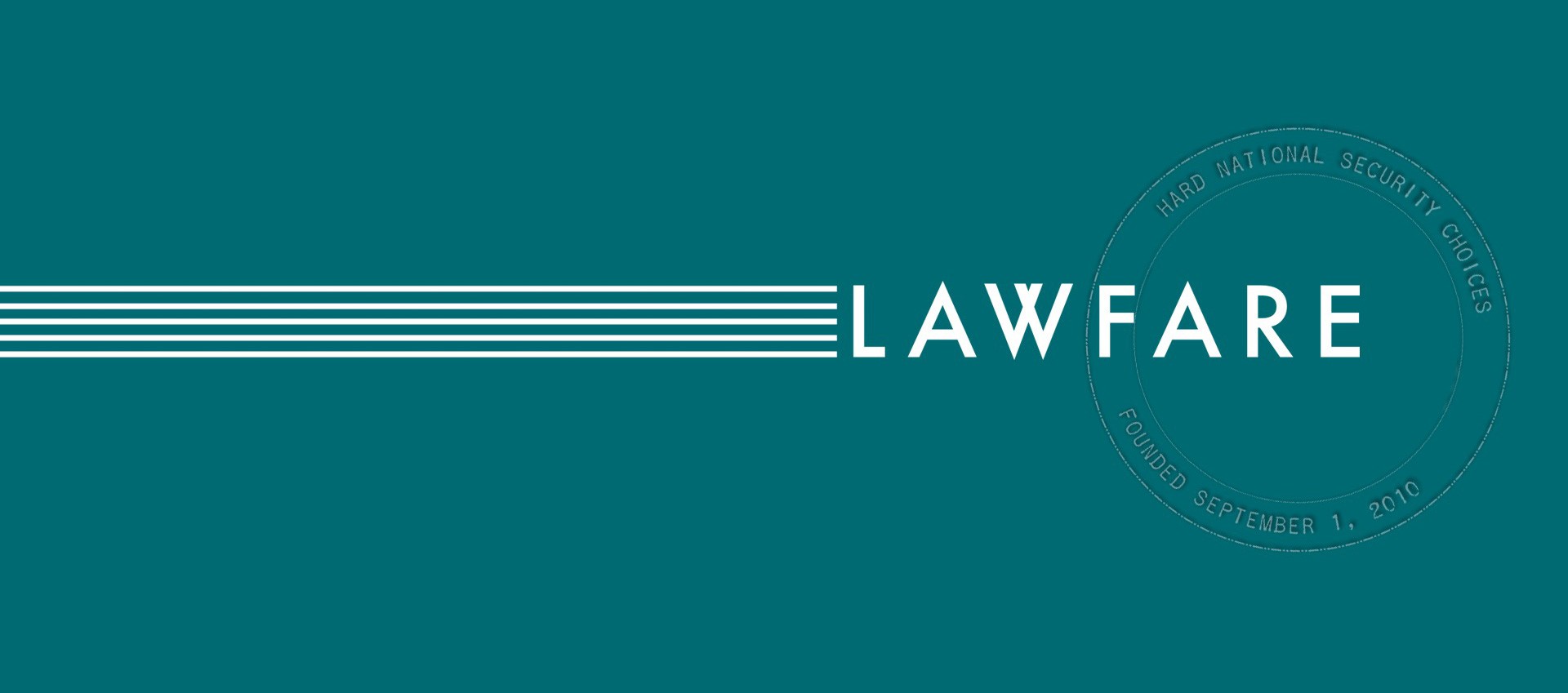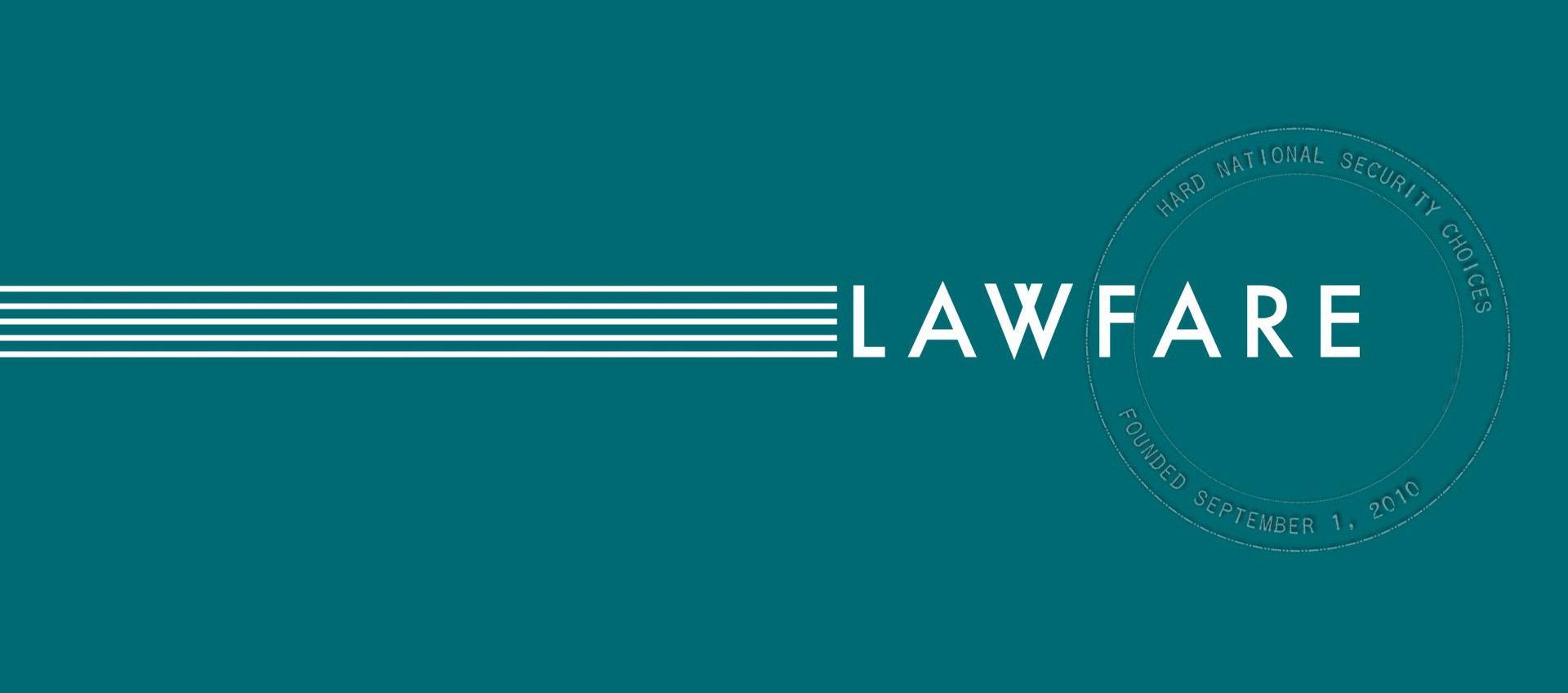If You Can’t Beat ’Em, Join ’Em
A new book argues that the best way to make the American internet less vulnerable to attack from authoritarian adversaries is to lock it down.

Published by The Lawfare Institute
in Cooperation With

A review of David Sloss, “Tyrants on Twitter: Protecting Democracies From Information Warfare” (Stanford University Press, 2022).
***
In 2009, during the Green Revolution that followed Iran’s presidential election, the U.S. State Department asked Twitter to delay its scheduled maintenance in order to keep the service running in Iran. The “technology is helping,” a senior official was quoted as saying, on the theory that many young Iranian activists were using Twitter to coordinate and build popular support. (Never mind that there was scant evidence that Iranian protesters actually used Twitter to mobilize protests; it was popular with elites who had connections to the West, so Americans thought it mattered.) At the time—the height of Western optimism about digital diplomacy—it had become U.S. foreign policy that Silicon Valley social media tools would spread democracy around the world, undermining authoritarian regimes.
Of course, as foreign policy this was a failure. The story is well known by now: For all the American hubris about the power of the internet to bring about democratic change, the internet turned out to be a boon to authoritarian states that have perfected digital authoritarianism. No one did a better job skewering the naivete of the West’s early digital statecraft than Evgeny Morozov, who wrote “The Net Delusion” 10 long years ago: “Failing to anticipate how authoritarian governments would respond to the Internet, cyber-utopians did not predict how useful it would provide for propaganda purposes, how masterfully dictators would learn to use it for surveillance, and how sophisticated modern systems of Internet censorship would become.” American optimism about the internet as a tool for regime change abroad turned to pessimism.
But there was still plenty of optimism about the internet at home. If the internet did not turn authoritarian states democratic, maybe it could enhance the democratic nature of open societies. Since free speech was already such a deeply embedded cultural norm in the West, what could be bad about having more speech? As Morozov himself wrote, “Democratically elected governments in North American and Western Europe may, indeed, see an Internet-driven revitalization to their public spheres as a good thing.”
Then 2016 happened. Authoritarianism seemed resurgent, not just abroad but at home. It almost seemed as if there was a correlation between the spread of social media around the world and the rise of authoritarianism. It was suddenly possible not only that the West was wrong about social media’s impact on authoritarian regimes, but that it might be bad for democracies too, maybe especially so. As Jack Goldsmith put it recently, “The optimistic hope that the internet might spread democracy overseas” crashed when Americans realized the “damage it has done to democracy at home.”
The list of ways that social media might be bad for democracies is long. But one particularly ironic way is that it makes them vulnerable to foreign information warfare. The “open internet” that the United States tried to convince so many countries to embrace turns out to be a perfect vector for foreign election interference.
David Sloss’s book, “Tyrants on Twitter,” is aimed at this particular problem: why democracies are uniquely vulnerable to social media attacks from abroad and what, if anything, to do about it. The book is divided into two parts: description and prescription. And while the first part is full of interesting stories and data that establish the seriousness of the problem, it is Sloss’s solution that illustrates the paradox at the heart of a democratic internet. In order to protect American democracy from foreign election interference, Sloss proposes stepped-up surveillance and a national database of registered social media users.
In other words, to keep the internet open and free, Western governments should lock it down.
The Problem
The bulk of Sloss’s book describes, in quite a bit of detail, the problem of democratic countries’ unique susceptibility to information warfare waged over social media by authoritarian countries such as Russia and China. Dividing the book between description and prescription is admirable. You could disagree with Sloss’s prescription—as I imagine many will—and still get a lot out of his detailed account of how authoritarian states are exploiting the West’s commitment to a largely unregulated digital world. Sloss explains some of the basics of information warfare and then identifies Russian-specific tactics, Chinese-specific tactics, and the asymmetry that exists between open and closed societies. This portion of the book will, I think, be useful for anyone teaching a class in information warfare today. For example, even if readers know many of the details of Russia’s information warfare tactics, it is harrowing to reread the way in which the GRU managed to, in Sloss’s words, “Hack and dump.”
At the same time, Sloss sometimes overclaims regarding the effect of operations on U.S. domestic politics. For example, Sloss describes the Russians’ three main goals in its 2016 election interference: to sow confusion about voting rules, to drive division among Clinton voters, and, in particular, to “exacerbate political polarization” by targeting inflammatory messages at right-wing extremists. Sloss concludes that the Russians succeeded, writing that “empirical analysis suggests that activity on social media by Russian cyber troops influenced public opinion in the United States in the months preceding the 2016 presidential election.” But did it make the difference? Sloss thinks so or at least that “an impartial observer who weighed all of the evidence could reasonably conclude that it is more likely than not that, absent Russian information warfare, Hillary Clinton would have won the 2016 election.” Unfortunately, the evidence for this claim is extremely thin. It is, necessarily, more opinion than fact.
Stronger evidence supports the claim that Russian operations have contributed to or are accelerating divisiveness in the country. One example, from August 2020, involves a large Black Lives Matter protest in Portland, Oregon, where a few isolated protesters appeared to burn a bible. A video financed by the Kremlin made it appear as if the entire protest was about Bible burning, not racial injustice. This story went viral and eventually caught the attention of Donald Trump Jr. and Sen. Ted Cruz, among the millions of people who saw it online. But the story is largely fabricated. This is a troubling example, but again the impact of these things is hard to pin down. (One wonders, too, how to measure the impact of a single piece of fake news when so much of what is seen online is faked or exaggerated in one way or another.)
Sloss is careful to distinguish China’s online influence efforts from Russia’s. Focused on “discourse power,” China’s efforts to shape the global internet have been aimed less at sowing division in the West than at reshaping the global international order to be friendly to the Chinese Communist Party. Sloss describes China’s multilayered strategy, which includes expanding China’s market power, through software like WeChat, TikTok, and other huge tech platforms; expanding China’s market power through hardware firms like Huawei that seek to embed themselves in the internet’s infrastructure; spreading content that is friendly to the party, which involves expanding Xinhua and other state-aligned news agencies; and, of course, covert actions like surveillance and hacking.
The most interesting part of Sloss’s descriptive account focuses on the asymmetry between democracies and autocracies in this space. As he puts it, the “combination of digital authoritarianism in autocratic states and the laissez-faire approach to regulating social media in democratic states creates an uneven playing field in the ideological competition between liberal democracy and authoritarianism.” It is not just that the internet is an asset for authoritarians, and a vulnerability for liberal democracies, but the combination of the two creates an asymmetry in information warfare capabilities, not unlike what is seen with terrorism and cyberattacks, where conventionally weak military powers like the Islamic State or North Korea are able to exploit the open nature of liberal societies.
Overall, Sloss’s descriptive story is a grim one. In 2022, American social media seems hugely costly for American democracy, and a boon for China and Russia.
Sloss’s Solution
So what’s to be done? One could imagine a range of responses to this problem. One possibility is to simply accept a certain degree of risk as a necessary cost of living in an open society. Another would be to educate social media users to detect fake news and efforts at disinformation—a kind of see something, say something strategy adopted from counterterrorism. Yet another approach, the one Sloss suggests, is to reconfigure the internet to be less open and more locked down, to make it more tightly controlled to prevent foreign influence operations. If there is a strategic asymmetry between authoritarian states and open societies, and it does not look like liberal democracy is spreading to authoritarian states anytime soon, the best path for liberal democracies is to tighten the reins on the internet. If you can’t beat ’em, in other words, join ’em.
Sloss’s plan here is complicated, but it boils down to this: The internet should be divided into clubs of, roughly, good guys and bad guys. The good guys club, which Sloss calls the “Alliance for Democracy,” should do what it can to keep bad guys out. Because the record of Silicon Valley’s giants is too poor to simply trust them to get it right, Sloss proposes “a registration system that will require social media users to register their account and declare their nationalities, including a verification system enabling governments of Alliance member states to verify that social media users who claim to be nationals of member states are, in fact, nationals of those states.” This registration system would keep out enemy foreign agents (Chinese spies) but let friendly users (French and British Twitter users) on America’s social media networks. How would this club be created? Sloss is a seasoned multilateral treaty negotiator, so it is little surprise that his solution is a multilateral treaty regime.
A national registration system to get online in America is hard to imagine. But rejecting this idea illuminates the problem with the current equilibrium in American internet regulation. Sloss’s idea of an internet registration system is a political nonstarter. Liberal and libertarian groups from the ACLU to the Cato Institute have vehemently opposed the idea of a national ID system, let alone one built for digital tracking. It’s just politically impossible.
But Sloss is right of course that the internet needs rules. So what’s to be done instead? So far, the default has been to leave it to the private market with a hope—it’s not much more than that, is it?—that these companies take the steps necessary to sustain American democracy.
This raises for me a series of larger questions about the proper role of the internet in a liberal democracy—questions that are related to, but unfortunately beyond, the scope of Sloss’s book.
Bigger Questions
Sloss’s book is focused on foreign influence operations, which, to be sure, are worth taking seriously. But in addition to whatever threat they have presented so far—the impact of the Russian influence operations is debatable—they suggest something deeper: cracks in America’s long-standing vision for the internet. They suggest that the Chinese and Russians were right when they warned, in 2009, that the internet could be weaponized through the “dissemination of information harmful to social and political systems.” And most importantly, they illustrate the tension between America’s liberal commitment to individual freedom and technology that threatens the republic. Sloss is aware of the paradox at the heart of his argument—the use of “illiberal policies to preserve the values of liberalism”—but he mostly skips over it in favor of detailing a treaty regime that would benefit NATO and undermine NATO enemies.
Answering the question of how—or whether—the U.S. navigates these tensions requires looking inward as much as outward. There are a number of small-c constitutional commitments in the U.S. that seem especially poorly suited to a digital world managed by private firms. For one, U.S. law and culture is hugely individualistic, oriented around individual rights rather than collective social harms like disinformation. This seems like a particular geopolitical disadvantage—one that I’d like to have seen Sloss spend more time analyzing. And America’s deep commitment to the distinction between public and private domains means that the public sector is hugely constrained while the private sector sets many of the rules for the digital world. This allows private firms to censor, discriminate, and surveil where the state could not, even where the state ultimately piggybacks on these actions. You may not want the government to set the rules for the metaverse, but is the alternative—Elon Musk and Mark Zuckerberg—better? And what about big-C constitutional issues? Sloss says Western democracies have failed to regulate social media to adequately protect democracy. But can they? This question is basically ignored until the final chapter, where Sloss admits that the First Amendment poses a significant barrier to serious state action.
Framing the future of the internet as a contest between liberal and illiberal countries, as Sloss does, elides a great deal. Most of all, it suggests that America’s internet is not already authoritarian. But is that right? In one obvious sense it is—compared to some authoritarian countries, the American government engages in less indiscriminate and direct surveillance on domestic networks, and does not directly censor online content. But from the user’s perspective, the digital world feels less and less free. Today’s users live under constant surveillance, with much of that surveillance ending up in government hands. Likewise, with speech—platforms have built massive and imperfect “content moderation” regimes, which are susceptible to government jawboning. And if you happen to say something that violates the rules of these content cartels, you risk being deplatformed across much of the modern digital world with no due process.
Sloss’s book is divided into “the problem” and “the solution,” but it can also be said that it is divided into “Them” and “Us,” where the problem is foreign agents—Russia and China—and the solution is a domestic tightening of state control over social media platforms. This framing assumes that within liberal democracy lies the answer to the problem, not the problem itself. I’m not so sure.




